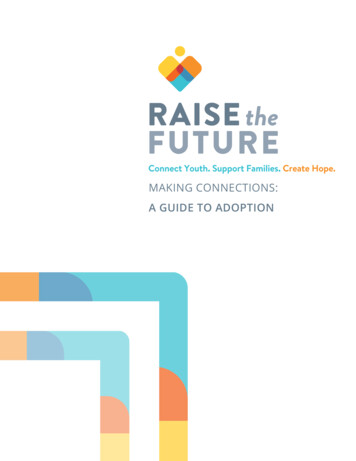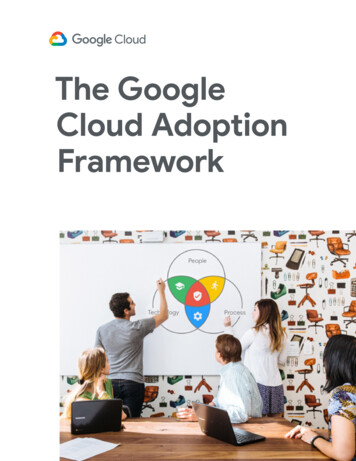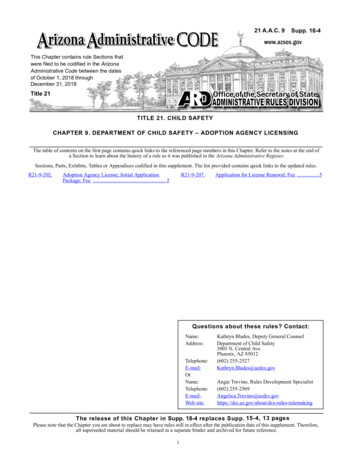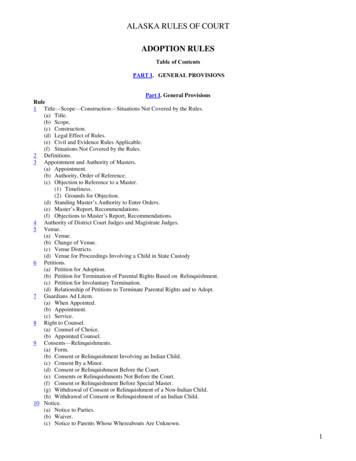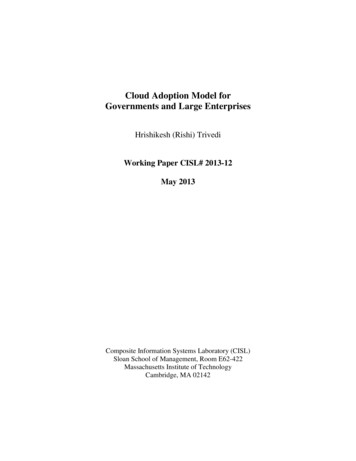
Transcription
Cloud Adoption Model forGovernments and Large EnterprisesHrishikesh (Rishi) TrivediWorking Paper CISL# 2013-12May 2013Composite Information Systems Laboratory (CISL)Sloan School of Management, Room E62-422Massachusetts Institute of TechnologyCambridge, MA 02142
Cloud Computing Adoption Model for Governments and LargeEnterprisesByHrishikesh TrivediB.E., Malaviya National Institute of Technology, India, 1999M.B.A, Indian Institute of Technology, India, 2001SUBMITTED TO THE MIT SLOAN SCHOOL OF MANAGEMENT IN PARTIALFUFILLMENT OF THE REQUIREMENTS FOR THE DEGREE OFMASTER OF SCIENCE IN MANAGEMENT STUDIESAT THEMASSACHUSETTS INSTITUTE OF TECHNOLOGYJUNE 2013 2013 Hrishikesh Trivedi. All Rights Reserved.The author hereby grants to MIT permission to reproduce and todistribute publicly paper and electronic copies of this thesis documentin whole or in part in any medium now known or hereafter created.Signature of Author:MIT Sloan School of ManagementMay 17, 2013Certified By:Stuart MadnickJohn Norris Maguire Professor of Information Technology, MIT Sloan School of Management & Professorof Engineering Systems, MIT School of EngineeringThesis SupervisorAccepted By:Michael A. CusumanoSMR Distinguished Professor of ManagementProgram Director, M.S. in Management Studies ProgramMIT Sloan School of Management
2[Page intentionally left blank]
3Cloud Computing Adoption Model for Governments and LargeEnterprisesByHrishikesh TrivediSubmitted to the MIT Sloan School of Management on May 10, 2013 inpartial fulfillment of the requirements for the degree of Master ofScience in Management StudiesABSTRACTCloud Computing has held organizations across the globe spell bound with its promise. As it movesfrom being a buzz word and hype into adoption, organizations are faced with question of how to bestadopt cloud. Existing frameworks of cloud adoption look at different aspects of cloud but stop short oftaking a view of the complete spectrum and suggesting a path.Cloud Computing adoption requires that organizations have readiness on multiple dimensionsincluding Governance, Process Analysis and Improvement, Application Rationalization andModernization, and Hardware and Software Standardization. Readiness in turn determines how farorganizations can go in their cloud programs with key milestones being Proof of Concepts,Infrastructure Service, Virtual Desktop, Platform Service and Enterprise Software as Service. Readinessand Milestones inform us about multiple stages in cloud adoption. The analysis also indicates thatcertain governance structures are most suitable for cloud adoption. The duration of cloud program fora large organization lies in years, even multiple five year plans.Analyses of case studies indicate all these views and the systems modeling for enterprise software asservice, in addition corroborates the likely duration of cloud program. For systems model we haveused factors such as Total Non-Cloud Applications, Rationalization and Modernization Rate, Rate ofConversion into Enterprise Software as Service and Budget.The proposed Cloud Computing Adoption Model can help organizations understand what capabilitiesthey need to develop, where they are on the cloud adoption spectrum and how much time it couldtake to go to cloud.Thesis Supervisor: Stuart MadnickTitle: John Norris Maguire Professor of Information Technology, MIT Sloan School of Management &Professor of Engineering Systems, MIT School of Engineering
4[Page intentionally left blank]
5AcknowledgementsI thank Prof Stuart Madnick and Allen Moulton for giving me the opportunity to work with them onthis thesis. I am grateful for their guidance, assistance, and time in directing my work towardssuccessful completion. Both Stuart and Allen reviewed my work with a fine toothcomb, gave feedbackthroughout the research process, suggested invaluable improvements, tolerated my naïve assertionsand made sure the work met MIT’s exacting standards.Prof Madnick was generous with his time to listen to my numerous status updates, sit through interimpresentations, question my assumptions and thought process, and helped me stay focused. Allenshaped this research by ensuring academic rigor, thorough literature review, hours of thoughtprovoking discussion, and sharing key resources. Allen also secured interviews with Large FinancialInstitution and Large AV Manufacturer, studied as part of this research, and made it a point to bepresent in each of those conversations.I am grateful to the people from the organizations studied who agreed to speak with me, discussabout cloud computing in general and give information about cloud computing programs within theirorganizations. Their contribution forms the basis of the view that this thesis puts forth.Arun Kumar Trivedi (ADG, CPWD, Govt. of India) connected me to key people in Government of India.Feng Ji (Sloan Fellow 2013) and Ming Fai (SDM 2013) helped me in reaching out to appropriate peoplewithin Singapore Government.I acknowledge the help I received from James Houghton in formulating and analyzing the systemsmodel to simulate conversion of enterprise applications into enterprise software as service.Heather Dill, Sloan Educational Services, reviewed my work and suggested improvements to make itmeet the standards laid down by MIT Sloan.Last but not the least I am grateful to Chanh Phan and Julia N. Sargeaunt for their support through theentire thesis process, conducting thesis information workshops and making the suggestion of workingwith Prof Madnick in the first place.
6[Page intentionally left blank]
7Table of Contents1INTRODUCTION . 111.11.21.31.4CLOUD COMPUTING TRENDS . 12CLOUD COMPUTING ADOPTION . 13CLOUD COMPUTING ADOPTION ISSUES AND STUDY OBJECTIVE . 14THESIS STRUCTURE . 152RESEARCH METHODOLOGY . 163LITERATURE REVIEW . 183.13.23.34CLOUD COMPUTING DEFINITIONS . 18CLOUD ADOPTION MODELS . 19TECHNOLOGY ORGANIZATION ENVIRONMENT FRAMEWORK . 22CASE STUDIES ON CLOUD ADOPTION PROGRAMS IN INDUSTRY AND GOVERNMENTS . 244.1 CASE STUDY - LARGE AV MANUFACTURER . 244.1.1Getting Set Up for Cloud . 244.1.2Cloud Philosophy . 254.1.3Cloud Programs . 254.2 CASE STUDY – GOVERNMENT OF INDIA . 264.2.1Cloud Computing Adoption in Federal and State Governments in India . 264.2.2Current Technology Adoption and Governance Model in Federal Government of India . 274.2.3Federal Government of India Technology Setup . 284.3 CASE STUDY – LARGE FINANCIAL INSTITUTION . 294.3.1Getting set up for Cloud . 304.3.2Cloud Program . 314.3.3Cloud Roadmap . 314.3.4Adoption Challenges . 344.3.5Adoption Enablers . 344.3.6Current State of Cloud . 354.3.7Measurement Metrics and Benefits . 364.3.8Future Plans . 364.4 CASE STUDY –SINGAPORE GOVERNMENT. 374.4.1Standard ICT Operating Environment (SOE) . 384.4.2Whole-of-Government Enterprise Architecture (WOG EA) . 394.4.3Supply, Support and Maintenance of Service Wide Hosting Service (SHINE) . 394.4.4G-Cloud Program . 404.4.5Cloud Implementation . 414.5 CASE STUDY – US INTELLIGENCE COMMUNITY . 424.5.1US IC Transformation Objectives and IC ITE Strategy . 42
84.5.24.5.34.5.45Execution Model . 43Execution Timeline . 44Elements of Transformation . 44CLOUD COMPUTING ADOPTION MODEL FOR GOVERNMENTS AND LARGE ENTERPRISES . 465.1 READINESS . 465.1.1Organizational Context . 465.1.2Technological Context . 485.1.3Environmental Context. 485.2 ADOPTION STAGES . 495.2.1Organizational Context . 495.2.2Technological Context . 495.2.3Environmental Context. 515.3 ASSESSING EXAMPLE ORGANIZATIONS ON CLOUD READINESS AND ADOPTION CRITERIA . 515.3.1Assessment of Organizations on Cloud Readiness and Adoption. 515.4 GOVERNANCE MODEL MAPPING . 555.5 MULTI YEAR EFFORT . 565.6 MULTIPLE SOURCES OF BENEFITS . 585.7 CLOUD ADOPTION MODEL . 595.7.1Thinking (about cloud) . 595.7.2Initiating (reach for cloud) . 605.7.3Creating (organizational cloud) . 605.7.4Riding (the cloud) . 616SYSTEMS MODELING . 636.1.1Systems Dynamics . 636.1.2Infrastructure Service . 656.1.3Development Platform Service . 666.1.4Enterprise Software as Service . 666.2 SIMULATION MODEL. 676.2.1Key Observations . 697CONCLUSION . 718AREAS OF FURTHER STUDY . 729APPENDIX . 739.19.29.310INTERVIEW QUESTIONNAIRE . 73TOE FRAMEWORK COMPONENTS. 77READINESS – ADOPTION ASSESSMENT SCORES . 78BIBLIOGRAPHY . 79
9AcronymsCIA - Central Intelligence AgencyCOTS - Commercial off The ShelfDIA - Defense Intelligence AgencyDNI - Director of National IntelligenceEA - Enterprise ArchitectureFBI - Federal Bureau of InvestigationFOC - Full Operating CapabilityIaaS - Infrastructure as a ServiceIC - Intelligence CommunityIC ITE - Intelligence Community Information Technology EnterpriseICT - Information and Communications TechnologyIDA - Info-Communications Development AuthorityIOC - Initial Operating CapabilityLAM - Large AV ManufacturerLFINT - Large Financial InstitutionNDC - National Data CenterNGA - National Geospatial-Intelligence AgencyNIC - National Informatics CenterNIST - National Institute of Standards and TechnologyNSA - National Security AgencyOS - Operating SystemPaaS - Platform as a ServicePMO - Program Management OfficePoC - Proof of ConceptRFP - Request for ProposalSaaS - Software as a ServiceSHINE - Supply, Support and Maintenance of Service Wide Hosting ServiceSOE - Standard ICT Operating EnvironmentTOE - Technology Organization EnvironmentUNDP - United Nations Development ProgramUSIC - United States Intelligence CommunityWOG EA - Whole-of-Government Enterprise Architecture
10List of FiguresFigure 1: Evolution of Cloud Computing (The Defense Science Board) . 11Figure 2: Essential Characteristics, Service Models, and Deployment Models of Cloud (NIST) . 12Figure 3: Hype Cycle for Cloud Computing 2012 (Smith) . 13Figure 4: Cloud Agenda Evolution (Kisker). 14Figure 5: Research Methodology . 16Figure 6: The Four Stages of Maturity for Private Cloud (Alvarez, Staten and McKee) . 19Figure 7: Cloud Maturity Model Domains (Mattoon, Hensle and Baty) . 20Figure 8: Cloud Computing Maturity Model (Jadhwani) . 21Figure 9: Maturity Model Comparison . 22Figure 10: Technology Organization Environment Framework (Baker) . 23Figure 11: Singapore Government Shine Platform (NCS Pte Ltd) . 40Figure 12: Singapore G Cloud Strategy (IDA of Singapore) . 41Figure 13: Cloud Readiness Dimensions . 46Figure 14: Cloud Adoption Milestones . 49Figure 15: Large AV Manufacturer Readiness and Adoption Scores. 52Figure 16: Government of India Readiness and Adoption Scores. 52Figure 17: Large Financial Institution Readiness and Adoption Scores. 53Figure 18: Singapore Government Readiness and Adoption Scores . 53Figure 19: US Intelligence Community Readiness and Adoption Scores. 54Figure 20: Relative Readiness Adoption Mapping . 54Figure 21: Governance Arrangement Matrix (Weill and Ross) . 55Figure 22: Governance Structure Mapping . 56Figure 23: Evolution of Cloud Programs . 57Figure 24: Cloud Program Objectives and Benefits Mapping . 58Figure 25: Cloud Adoption Model . 62Figure 26: Reinforcing Loop . 63Figure 27: Balancing Loop . 63Figure 28: Population Stock and Flows . 64Figure 29: Population Stock and Flows with Units . 64Figure 30: Population Stock and Flows with Units and Auxiliary Variables (Sterman) . 64Figure 31: Infrastructure Service Stock Flow Model . 65Figure 32: Platform Service Stock Flow Model . 66Figure 33: Enterprise Software as Service Stock Flow Model . 67Figure 34: Simulation Model . 68Figure 35: Simulation Run Parameters . 69Figure 36: Total Non-Cloud, Modernized and Enterprise Software as Service Applications over Time . 69Figure 37: Capital Needed for Conversion of Applications to Enterprise Software as Service . 70
111 INTRODUCTIONThe advent of Computing revolutionized postindustrial society and Cloud Computing shows signs ofrevolutionizing the information society. Cloud Computing has been very often portrayed andperceived as a new technology but it is also widely accepted as evolution of technologies such asclient server architecture, World Wide Web, and networking. Some even call it mainframe 2.0.In 1960s mainframes were used for computing and transaction processing with users accessing thecomputing resources through ‘dumb terminals’. 1980s saw the advent of protocols for networking andclient server architecture. “The ability to connect users to computing and data resources viastandardized networks emerged as a key enabler of cloud computing” (The Defense Science Board).The World Wide Web and the Internet followed in the 1990s along with enablers such as webbrowsers. The decade also saw the emergence of application service providers, offering softwarepackaged as service over the internet. Refer Figure 1 for graphic on evolution of computing.Figure 1: Evolution of Cloud Computing (The Defense Science Board)“Cloud computing has been enabled by the availability of broadband networks and inexpensive end‐user devices, as well as commodity computing nodes that can be simply interconnected andcontrolled, and virtualization to provide the appearance of isolating processes that share computers”(The Defense Science Board).
12Given the evolutionary nature of Cloud Computing, it could mean different things and thus it isprudent to pay attention to definition of Cloud Computing.“Cloud Computing is a model for enabling convenient, on-demand network access to a shared pool ofconfigurable computing resources (e.g. networks, servers, storage, applications, and services) that canbe rapidly provisioned and released with minimal management effort or cloud provider interaction”(Information Technology Laboratory - National Institute of Standards and Technology). NIST also laysdown Essential Characteristics, Service Models, and Deployment Models as shown in Figure 2.Figure 2: Essential Characteristics, Service Models, and Deployment Models of Cloud (NIST)1.1 CLOUD COMPUTING TRENDSCloud Computing is one of the most talked about technology trends of the last decade. Enterprisesclaim to be on the path to being cloud centric, vendors speak about cloud strategy, and industryanalysts spend their time following the cloud revolution.All these can be taken as signs of hype, which might be tapering off as organizations get serious aboutcloud, and experience its true benefits and challenges. Industry and analysts alike expect cloud tobecome main-stream not immediately but over the course of next several years. Refer Figure 3 forHype Cycle (Smith).Cloud Computing as Complement: Enterprises see Cloud Computing as complementary to theirexisting infrastructure, not as replacement (Kisker). This affords them the flexibility to harness thebenefits of cloud and reap returns on the investments that they have already made.Increased Spending on Cloud: Governments, Public Sector and Private Enterprises alike are eithergradually allowing Cloud Computing to percolate into their structure, processes and infrastructure orare initiating programs which help them build on their past programs and realize the benefits of cloud.It also means that they are allocating budgets or increasing spend on Cloud Computing related
13programs. “Worldwide spending on public IT cloud services will be more than 40 billion in 2012 andis expected to approach 100 billion in 2016” (IDC).PaaS Emerges Out of the Shadows: SaaS (e.g., Salesforce.com) and IaaS (e.g., Amazon EC2) have cometo be recognized as key cloud services and there are expectations that PaaS (e.g., Salesforce.comAppexchange) offerings will grow “as the market moves up the software stack” (IDC).Governments and Public Sector lag Private Sector: Government and the public sector are behind theprivate sector across all aspects of adopting cloud including developing strategy, proof of concept,and staged implementation (KPMG). Governments and public sector see security as a key concern tobe addressed. Governments in Australia, Japan, Singapore, UK and US are pursuing or initiating cloudprograms and these programs have been closely followed by industry analysts.Figure 3: Hype Cycle for Cloud Computing 2012 (Smith)1.2 CLOUD COMPUTING ADOPTIONSpurred on by industry trends, Cloud Computing - Cloud - has gradually found traction amongst smalland medium businesses, large enterprises and now governments and public sector. New businessesincreasingly look to start in the cloud. The efforts of enterprises and public sector are findingresonance amongst vendors across all cloud service categories. Cloud adoption is almost equally beingdriven from the top and bubbling up from the bottom.
14BENEFITSGovernments, local authorities, public sector organizations, and entities cutting across for profit andnonprofit spectrum intend to become Faster, Better, and Cheaper when they go in for CloudComputing.Enterprises seek operational agility, improvement in business processes, higher business usersatisfaction, lower costs, and infrastructure scalability from their cloud programs (Kisker). There mighteven be a perceptible change in expectations from cloud taking place as enterprises go through theprocess of cloud adoption as indicated in Figure 4.Figure 4: Cloud Agenda Evolution (Kisker)Though governments and public sector have tempered expectations from cloud, the benefits whichthey look forward to are; transparency, reduced costs, and better interaction with citizens andsuppliers (KPMG).CHALLENGESThe adoption of cloud is all but a smooth ride. Cloud is a threat to traditional power andorganizational structures in a firm as business units can bypass IT organization to procure required ITservices viz., infrastructure, applications over cloud, a phenomena termed by firms as Shadow IT(groups within agencies setting up their own IT infrastructure or contracting independently with thirdparty service providers). IT organizations in turn try to assert their presence through enforcement ofpolicies. As a silver lining, progressive CIOs see cloud as an opportunity to convert the IT organizationinto a revenue center.Other challenges in adoption of Cloud Computing are articulating a clear vision, creating a goodbusiness case, establishing quick wins, and having experienced resources. Security is a concern withalmost every entity on cloud or looking to be in cloud.1.3 CLOUD COMPUTING ADOPTION ISSUES AND STUDY OBJECTIVECloud Computing is helping enterprises and public sector address issues of cost, efficiency, flexibility,and scalability among others but at the same time is also raising many questions.How should government, public sector or a large enterprise go about adopting cloud? Is there aparticular path to be followed? Are certain steps necessary to cloud adoption process? Do certaincharacteristics define organizations in the process of cloud adoption? Should certain competencies be
15developed for successful move to cloud? How do different organizations at different stages of cloudadoption look different from each other? Are there any examples to refer to?The objective of this thesis is to answer these questions by studying in depth large enterprises andgovernments which are either thinking of moving to the cloud or have taken steps to adopting cloud,identify any emerging patterns, explore drivers of cloud computing, and craft a model for cloudcomputing adoption.I lay emphasis on governments because literature on cloud computing adoption with governments inperspective is lacking. Governments merit academic attention because they are complex institutions,largest employers across globe, and one of the biggest spenders on technology, but have not been atforefront of cloud computing.1.4 THESIS STRUCTUREThis thesis is organized into seven chapters in addition to introductory Chapter 1. Chapter 2 lays outthe research methodology to acquaint the reader with the multi-dimensional research conducted.Chapter 3 gives a snapshot of the literature survey including definitions of cloud computing, cloudcomputing adoption models and appropriate theoretical construct to organize the study. Chapter 4contains detailed case studies of organizations studied. Chapter 5 contains inferences from the casestudies, assessment of cloud programs of the organizations, and proposed model for cloud adoptionfor a large organization. Chapter 6 contains systems models of cloud adoption, simulation model forenterprise software as service and simulation results. Chapter 7 presents conclusion from the studyand Chapter 8 identifies areas of future work.
162 RESEARCH METHODOLOGYThe introduction gave a flavor of the multiple dimensions of Cloud Computing including some of thequestions which this thesis attempts to answer. Before we get into discussion of Cloud Computing andits adoption, it shall be worthwhile to review the study approach.In this study an attempt has been made to broad base the research and use a multi-prongedapproach. The study derives its insights from a combination of primary research, secondary researchand systems modeling as depicted by Figure
Cloud Computing has held organizations across the globe spell bound with its promise. As it moves from being a buzz word and hype into adoption, organizations are faced with question of how to best adopt cloud. Existing frameworks of cloud adoption look at different aspects of cloud but stop short of . 4.3.7 Measurement Metrics and Benefits .

